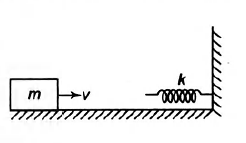Q.
A block of mass m is moving with a speed $v$ on a horizontal rough surface and collides with a horizontally mounted spring of spring constant
$k$ as shown in the figure. The coefficient of friction between the block and the floor is $\mu$ The maximum compression of the spring is

Work, Energy and Power
Solution: